Kathy Demchak, Matt Cooper, and Rich Marini (Penn State University); Maria Cramer (Univ. of Maryland, formerly Penn State)
High tunnels are widely used for raspberry production in much of the world, and it is easy to understand why. The longer growing season, increased yields and improved quality, and the ability to schedule tasks without concerns, for example, the occurrence of rain changing plans make tunnel production appealing. Growers also often cite improved fruit appearance as a reason for growing raspberries in high tunnels (Figure 1).
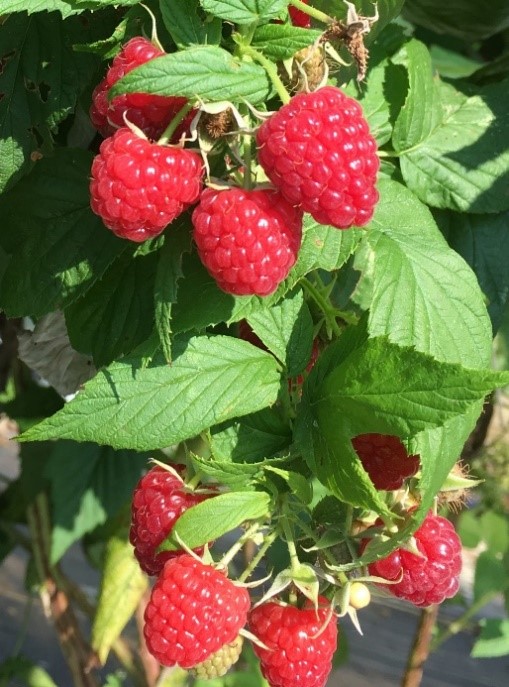
From 2015 to 2019, a trial was conducted at Penn State as part of a large SCRI project “Optimizing the Protected Culture Environment for Berry Crops”, led by Eric Hanson at MSU. This part of the project looked at high tunnel production of raspberries and strawberries with the goal of determining whether plastic-type affected yield and pest complexes (Figure 2).
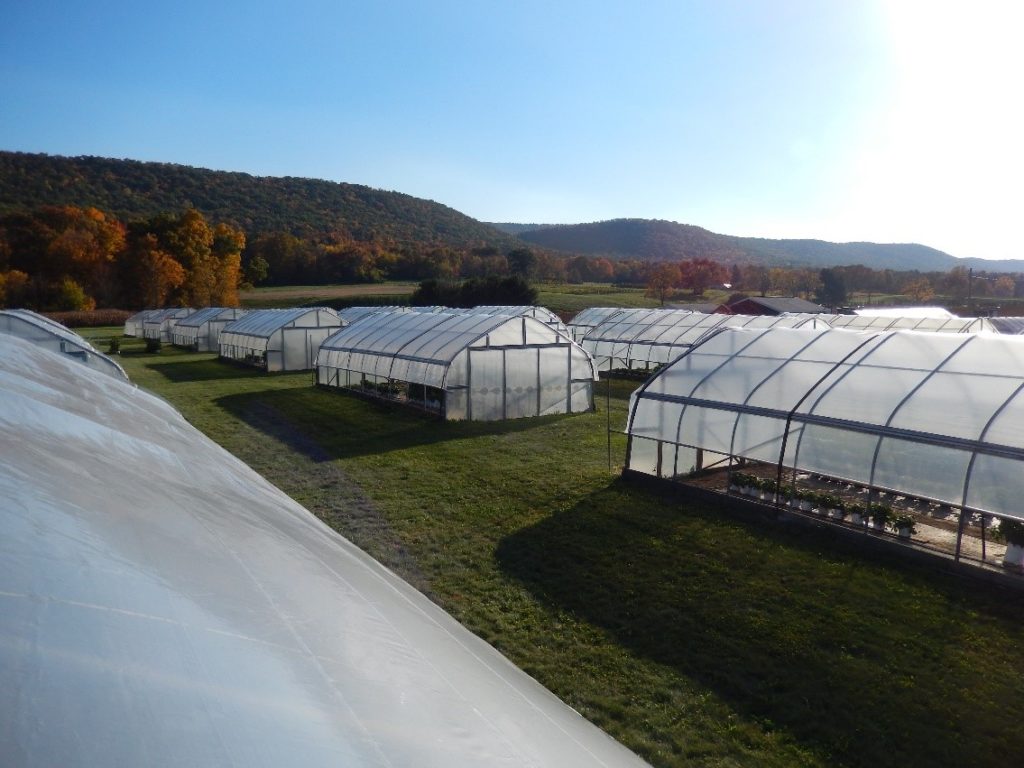
How Do Plastic Covers Differ?
Plastic films used on high tunnels are typically 6-mil thick, and are categorized as “clear” or “diffuse”. Clear plastics scatter light less, and diffusing plastics scatter light more. In specification sheets for plastics, this is often referred to as “clarity” vs. “haze”. With a diffusing plastic film, light should be spread more evenly throughout the tunnel and the plant canopy, theoretically making better use of available sunlight and decreasing sunburn (Figure 3a and Figure 3b). You also may see references to “light transmission”, or “light transmissivity”. This describes how much visible light (which also covers the range of wavelengths that plants use for photosynthesis) passes through the plastic film. With a new plastic cover, 85-90% transmission is common for the majority of clear and diffusing plastics. You’ll also see references made to the plastic films being either “UV-blocking”, or “UV-stabilized”. UV light breaks plastic down without additives to protect it. If a UV-blocker is used, UV light is prevented from passing through the plastic, much like a UV-blocking sunscreen would work. If the plastic is UV-stabilized, the plastic contains an additive that prevents the plastic’s chemical bonds from being broken down, but most of the UV light still passes through. This is what allows a high tunnel film to typically have a 4-year life, rather than becoming brittle and falling apart. Then there are “IR” films, which partially prevent the wavelengths that we feel as heat from entering the tunnel during the day and being emitted at night. And finally, there are AD (anti-drip), and AC (anti-condensate) film additives or coatings, which keep water droplets from condensing and coalescing on the plastic in large droplets and falling onto your plants. With most films, there is no “inside” or “outside” to the film, so it doesn’t matter if it gets flipped, but sometimes it does make a difference if there is a coating. This will be marked on the plastic itself. Plastics can vary in their pricing, though we found that there were bigger price differences between different suppliers of the same plastic type rather than between different plastics. Shipping costs can easily add another 50% to the cost of a plastic.
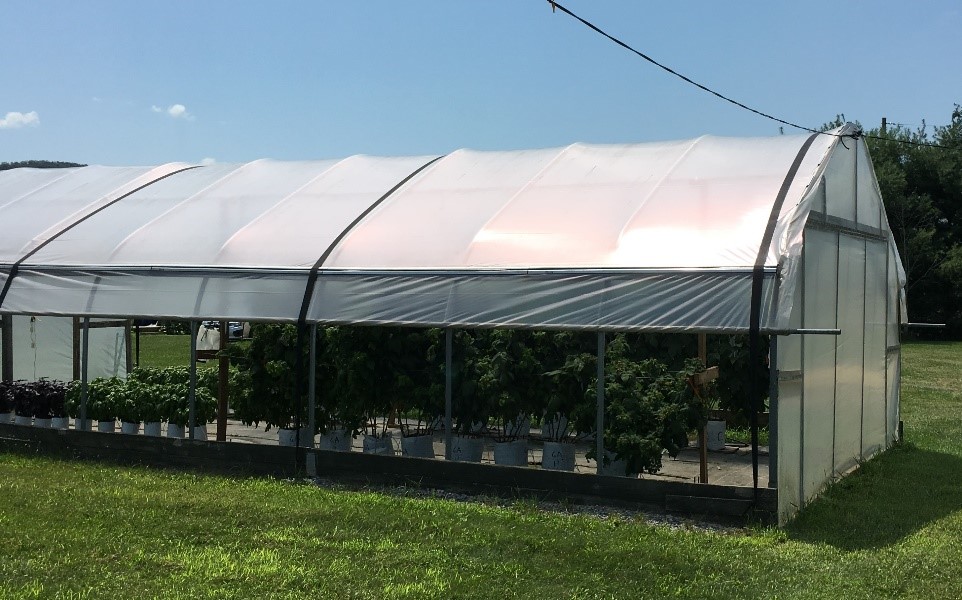
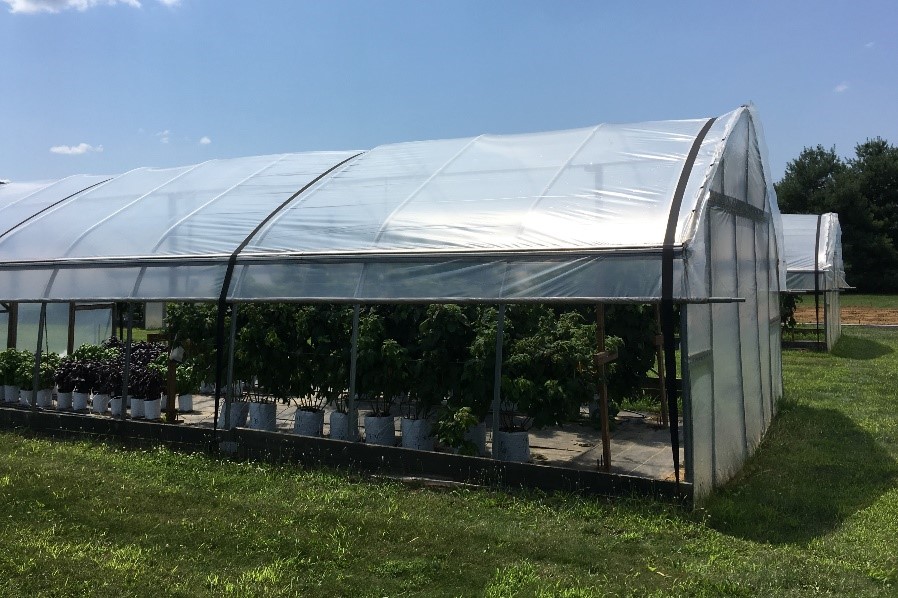
Plastics Trialed
We first screened over 50 plastics available to growers in North America for their light transmittance characteristics and picked three commercially available ones that were different from each other in visible, IR, and UV light transmission and two experimental films. Commercially-available films chosen were Berry Plastics Tufflite IVTM (TIV), RKW-Klerks KoolLite Plus (KLP), and Ginegar Sunsaver (GSS). The two experimental films, (UV-T and UV-O) differed only in UV transmission and were included in a study on Japanese beetle. Of these films, all were highly diffusing except for TIV. All transmitted about 85-90% of the visible light, except for KLP which transmitted about 70%. KLP also blocked some IR light, keeping tunnels cooler during the day compared to other plastics and warmer at night. TIV and UVT transmitted about 80% of UV-A and UV-B light, KLP blocked UV-B light but allowed most of the UV-A through, and GSS blocked some of both. UV-O blocked nearly all UV light. Three tunnels were covered with each plastic, plus three were left uncovered. Cover treatments were arranged in a randomized complete block design.
‘Josephine’ and ‘Polka’ raspberry plants (12 per plot) were grown in soilless media in growbags to avoid confusing differences from plastics with differences from variation in soil nutrients in each tunnel. Bags were 3-gallon at first, but plants were repotted into 5-gallon bags after the first winter. The media was an unamended 2:1 peat:perlite mix and plants were grown in a constant-feed system using 20-7-20 soluble fertilizer for high bicarbonate waters at 100 ppm N. This worked well for our climate and our water source, but other systems may work better in other locations. Plants remained in the tunnels for the winter of 2016-17 and were overwintered by being laid down and covered with row covers, but started growing too early in the spring. Thus, they were moved into the lower level of an unheated bank barn for the following winter. This impacted differences in first date of harvest in the subsequent years. In 2017, harvest began on May 26 in all tunnels except for those covered with KLP for ‘Josephine’, where harvest began on May 30, while harvest for plants with no cover began nearly a month later on June 23. Harvest ended on Nov. 8 for all treatments in 2017, even for plants with no cover. In 2018, harvest started on June 13 for ‘Polka’ in tunnels covered with any type of plastic, but for ‘Josephine’ started June 13 under TIV, June 15 under GSS, and June 20 under KLP. Harvest of plants under no cover started June 15 for ‘Polka’ and June 20 for ‘Josephine’. Harvest ended on Oct. 25 for plants with no cover, and Nov. 19 for plants in tunnels in 2018. In both years, plants were harvested 3 times per week through the first week of September and twice per week thereafter.
What did we think would happen?
Raspberries prefer cool to moderate temperatures and since tunnels can get quite hot during the summer, our theory was that plants in tunnels covered with KLP might perform best. Though visible light levels were lower under KLP, raspberry plants reach “light saturation” at fairly low light levels, so we thought this might make little difference. We also thought that TIV-covered tunnels might be too hot and plants in them would yield less.
What actually happened?
In a nutshell, the opposite of what we thought. Total yields were highest in tunnels that were the warmest during the day (covered by Tufflite IV), and lowest in those that were the coolest (covered by KoolLite Plus). ‘Josephine’ produced total yields 23% higher, and Polka, yields that were 11% higher in tunnels covered with TIV than with KLP. Yields in tunnels covered with Ginegar Sunsaver were intermediate. On two dates in early Sept. 2018 when it was very hot though, there was a larger proportion of ‘Polka’ fruit showing symptoms of sunscald under TIV plastic, a non-diffusing highly transmissive plastic, than under the other films, though the amount of sunscald in all of the tunnels was much less than for plants with no cover at all. When marketable yield was considered, the same overall trends still held as with total yield. Berry size was larger under all plastics than no plastic for both cultivars. There were some differences in the percentages of marketable fruit between plastic types, but they were minimal.
To put things in perspective, plants in tunnels covered with any kind of plastic greatly outyielded plants that were not covered, and these differences somewhat dwarfed the differences between plastics. For ‘Josephine’, total yields in tunnels were 2.5 to 3 times as high as outside yields, and for ‘Polka’, yields were 4 to 5 times greater, depending on the plastic type. It is likely that differences in nutrition accounted for some of the difference between indoor and outdoor yield, since the potting media for outside plants was subjected to some leaching from rain.
Differences between covered tunnels, however, were due entirely to plastic type and its range of effects. Varieties responded slightly differently in the different years, but when yield was averaged over years, trends on how they responded to plastics were the same for both.
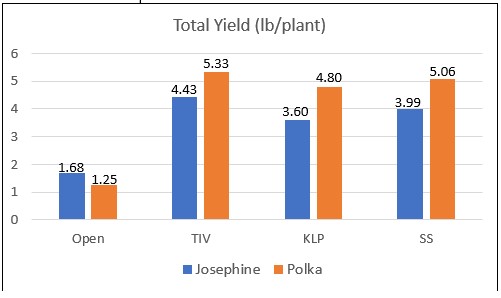
So, why would yields have been higher under TIV where temperatures were higher than under KLP where temperatures were lower? We think that the yield increases were really driven by conditions in the spring and the fall, when warmer temperatures are spurring growth and prolonging higher yields, rather than effects in the summer when the tunnels are fully vented. Thus, some of the negative effects that could have occurred from high temperatures might have been moderated in the summer due to the tunnel sides being up (Figure 4). Regarding pest complexes, the biggest differences were in Japanese beetle populations. Japanese beetles were counted and removed from each 12-plant plot from mid-July through the end of August. All plastics decreased their numbers, but the plastic that diffused light and blocked UV resulted in the largest decreases (Figure 5). This could have large implications for future pest management tactics.
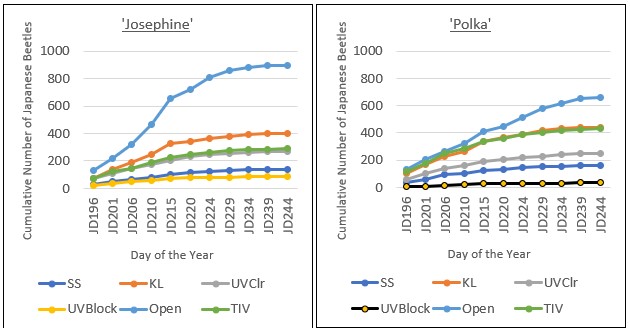
The Bottom Line
Effects and the best plastics to use would likely be different in different environments, and results could have been entirely different in a warmer location. However, for our location in central PA: 1) Any plastic was better than no plastic. 2) The 6-mil plastic that was the least expensive and the easiest to obtain in PA (TIV) resulted in higher yields than any other plastic. So there appeared to be no yield-related reason to pay for a more expensive plastic, and durability was similar for all of the plastics tested. 3) If you are trying to manage plants as pesticide-free or organically, at least for Japanese beetle control, you may want a film that blocks UV light possibly in combination with diffusing light. However, while not discussed above, tunnels that transmitted more UV light had fewer adult spotted wing drosophila caught in traps and lower levels of fruit infestation than those that didn’t transmit much – but this was not enough to make a difference in other practices needed for controlling the fly. 4) If you own more than one tunnel, you might want to try different plastics on your tunnels in the same year to be able to make a comparison on your own farm. 5) If you live in an area warmer than central PA, consider the results cautiously, since factors like sunscald will probably become more important to you if using a non-diffusing plastic. But if you live in a similar or cooler area, you probably don’t want to choose a plastic that reduces temperatures.
This work is based upon research supported by the USDA National Institute of Food and Agriculture, Section 7311 of the Food, Conservation and Energy Act of 2008 (AREERA), Specialty Crops Research Initiative under Agreement 2014-51181-22380.